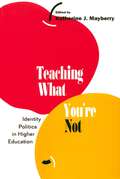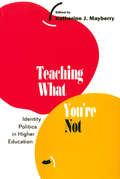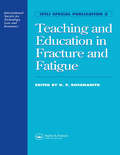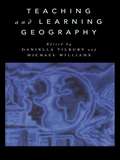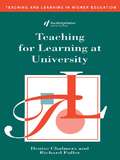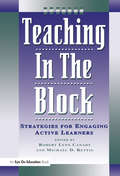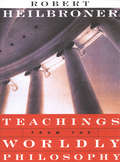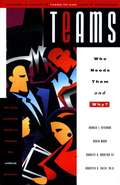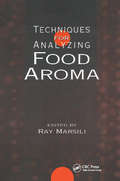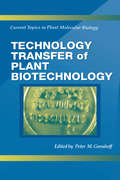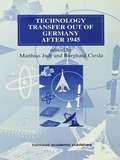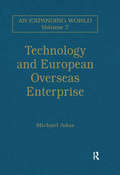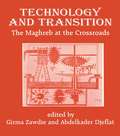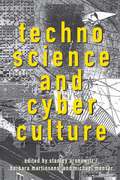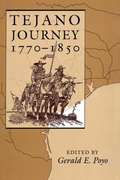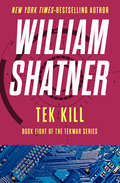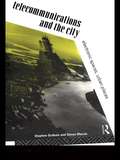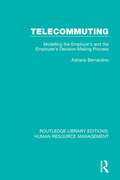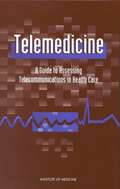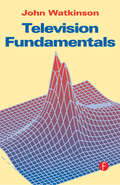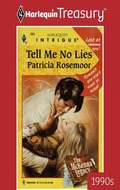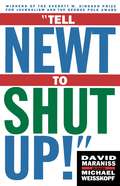- Table View
- List View
Teaching What You're Not: Identity Politics in Higher Education
by Katherine J. MayberryExamines the roles of historical, cultural, and personal identities in the classroomCan whites teach African-American literature effectively and legitimately? What is at issue when a man teaches a women's studies course? How effectively can a straight woman educate students about gay and lesbian history? What are the political implications of the study of the colonizers by the colonized? More generally, how does the identity of an educator affect his or her credibility with students and with other educators? In incident after well-publicized incident, these abstract questions have turned up in America's classrooms and in national media, often trivialized as the latest example of PC excess. Going beyond simplistic headlines, Teaching What You're Not broaches these and many other difficult questions. With contributions from scholars in a variety of disciplines, the book examines the ways in which historical, cultural, and personal identities impact pedagogy and scholarship. Essays cover such topics as the outsider's gaze as it applies to the study of non-white literature; an able-bodied woman's reflections on teaching literature by disabled women; and the challenges of teaching the Western canon at an African American college.
Teaching What You're Not: Identity Politics in Higher Education (Open Access Lib And Hc Ser.)
by Katherine J. MayberryCan whites teach African-American literature effectively and legitimately? What is at issue when a man teaches a women's studies course? How effectively can a straight woman educate students about gay and lesbian history? What are the political implications of the study of the colonizers by the colonized? More generally, how does the identity of an educator affect his or her credibility with students and with other educators? In incident after well-publicized incident, these abstract questions have turned up in America's classrooms and in national media, often trivialized as the latest example of PC excess. Going beyond simplistic headlines, Teaching What You're Not broaches these and many other difficult questions. With contributions from scholars in a variety of disciplines, the book examines the ways in which historical, cultural, and personal identities impact on pedagogy and scholarship. Essays cover such topics as the outsider's gaze as it applies to the study of non-white literature; an able-bodied woman's reflections on teaching literature by disabled women; and the challenges of teaching the Western canon at an African American college.
Teaching and Education in Fracture and Fatigue
by H. P. RossmanithThis proceedings contains the best contributions to the series of seminars held in Vienna (1992), Miskolc, Hungary (1993 and 1994) and Vienna (1995) and provides a valuable resource for those concerned with the teaching of fracture and fatigue. It presents a wide range of approaches relevant to course and curriculum development. It is aimed particu
Teaching and Learning Geography
by Michael Williams Daniella TilburyThis book provides a clear overview of current thinking on the teaching and learning of geography. It is an ideal companion to all students beginning a career in teaching the subject in secondary schools.The chapters are written by experienced teacher educators and bridge both theory and practice. The writers focus on the continuities, whilst setting them in the context of the changing curriculum.The book is divided into four parts. Part One examines the historical context of geography teaching. Part Two looks at issues of course planning, design, syllabuses and programmes of study. Underlying this section is the assumption that geography should not be considered in isolation from other subjects, but rather as part of a whole curriculum. Part Three concentrates on teaching and learning, and includes chapters on the use of maps, field work, IT and first hand experience within a community. The final section covers the issues associated with assessment, across the whole school age range.
Teaching for Learning at University (Teaching and Learning in Higher Education)
by Denise Chalmers Richard FullerThis text looks at how university teachers can teach their students learning strategies. It describes how teachers can teach each strategy in their normal classes and encourage students to use the strategies in their own study time. It includes case studies.
Teaching in the Block: Strategies for Engaging Active Learners
by Michael D. Rettig Robert Lynn CanadyThis bestseller describes alternatives to lecturing, traditional questioning, and individual pencil and paper tasks. It offers practical advice on how teachers can harness the potential of the extended period.
Teachings from the Worldly Philosophy
by Robert L. HeilbronerSelections from great writings on economics, annotated and introduced by a distinguished economist and teacher. Author of The Worldly Philosophers, a 3-million-copy seller, Robert Heilbroner offers here a compendium of readings from the "worldly philosophers" themselves. The selections range from the earliest economic thought to such towering volumes as Adam Smith's The Wealth of Nations, Thomas Malthus's Essay on the Principle of Population, David Ricardo's Principles of Political Economy, and John Maynard Keynes's The General Theory of Employment, Interest, and Money. Acting as "a docent, not merely an editor," he takes the reader through the core arguments with "brilliantly clear commentary" (New York Times Book Review).
Team New Zealand (A)
by Marco IansitiThe case describes the development process used by Team New Zealand to design their two yachts for the 1995 America's Cup. During development, the team makes extensive use of simulation and physical prototyping to improve the initial design concept. As they approach construction, they must decide whether to build both boats at the same time and, if so, whether to vary their designs. The decision hinges on evaluating the benefits of different experimentation strategies. Includes color exhibits.
Teams
by Jennifer Jolly David Wade Ronald Recardo Charles A Mention IiiIs team-based management best for your business? Will it help your organization meet the challenges of the twenty-first century to cut production costs, increase quality and service, and compete in the global economy? his practical, immensely informative book will help you make that decision. Teams tells you:When to use teams and when not to use them. What conditions must exist for teams to be successful. Which teams are appropriate for a particular situation. How to develop teams to meet the specific needs of your organization.
Techniques for Analyzing Food Aroma: Food Aroma (Food Science And Technology Ser. #79)
by Ray MarsiliCovers important methods and recent developments in food-aroma analysis. The text discusses the problem-solving capabilities of analytical methods for food flavours and aromas, showing how to select appropriate techniques for resolving the problems of major food trends. It includes a treatment of off-flavour and malodor analyses and new polymer sensor array instruments.
Technology Transfer of Plant Biotechnology (Current Topics In Plant Molecular Biology Ser. #3)
by Peter M. GresshoffPlant biotechnology has come of age. Products obtained by genetically engineered methods, once limited to science fiction, have become a reality. This book is an outstanding synthesis of the current status of technology transfer from the laboratory to the marketplace. It discusses the use of genetically engineered crops, with the focus on biotechnology becoming commercially marketable. Technology Transfer of Plant Biotechnology addresses these important new products.
Technology Transfer out of Germany after 1945 (Routledge Studies in the History of Science, Technology and Medicine #2)
by Burghard Ciesla Matthias JudtTechnology Transfer Out of Germany studies the movement of technology and scientists between East Germany and the Soviet Union, and West Germany and the Western Allies, using documented examples and case studies, and asks whether the confiscation of documents, equipment and scientists can really be considered to be a form of 'intellectual reparation.'
Technology and European Overseas Enterprise: Diffusion, Adaptation and Adoption (An Expanding World: The European Impact on World History, 1450 to 1800)
by Michael AdasTechnological innovation was crucial to the process of European expansion: advances in astronomy and navigation and changes in weaponry all contributed to the emergence of European commercial enclaves in Africa and Asia, and the conquest of the Americas. This volume illustrates the ways in which these European technological advantages shaped the expansion of the global system, whilst making clear that Western technology both adapted models from other cultures and was at times seriously challenged by them. In the arts of war, the West had much less of a technological edge over its Asian adversaries than is usually believed. Substantially dealing with the issue of technology transfer between the world and Europe, these studies underline the interactive nature of the process.
Technology and Transition: The Maghreb at the Crossroads
by Abdelkader Djeflat Girma ZawdieThe Maghreb countries had a promising start in economic growth after independence. For the most part they thrived on industrialisation by import substitution; but unfortunately this strategy left them with macroeconomic and structural imbalances which together have effectively constrained their ability to compete in the world economic system and to catch up with the rapidly changing global techno-economic circumstances. Issues relating to aspects of technology transfer to the Maghreb, strategies for technological and resource development and the integration of education and R&D systems with the productive systems of the economies in the region are discussed along with relevant cases from Mexico, China, South Korea, India and Bangladesh.
Technoscience and Cyberculture: A Cultural Study
by Stanley Rronowitz, Barbara Martinsons, and Michael Menser with Jennifer RichTechnoculture is culture--such is the proposition posited in Technoscience and Cyberculture, arguing that technology's permeation of the cultural landscape has so irrevocably reconstituted this terrain that technology emerges as the dominant discourse in politics, medicine and everyday life. The problems addressed in Technoscience and Cyberculture concern the ways in which technology and science relate to one another and organize, orient and effect the landscape and inhabitants of contemporary culture.
Tejano Journey, 1770-1850
by Gerald E. PoyoA century before the arrival of Stephen F. Austin's colonists, Spanish settlers from Mexico were putting down roots in Texas. From San Antonio de Béxar and La Bahía (Goliad) northeastward to Los Adaes and later Nacogdoches, they formed communities that evolved their own distinct "Tejano" identity. In Tejano Journey, 1770-1850, Gerald Poyo and other noted borderlands historians track the changes and continuities within Tejano communities during the years in which Texas passed from Spain to Mexico to the Republic of Texas and finally to the United States. The authors show how a complex process of accommodation and resistance--marked at different periods by Tejano insurrections, efforts to work within the political and legal systems, and isolation from the mainstream--characterized these years of changing sovereignty. While interest in Spanish and Mexican borderlands history has grown tremendously in recent years, the story has never been fully told from the Tejano perspective. This book complements and continues the history begun in Tejano Origins in Eighteenth-Century San Antonio, which Gerald E. Poyo edited with Gilberto M. Hinojosa. A century before the arrival of Stephen F. Austin's colonists, Spanish settlers from Mexico were putting down roots in Texas. From San Antonio de Bexar and La Bahia (Goliad) northeastward to Los Adaes and later Nacogdoches, they formed communities that evolved their own distinct "Tejano" identity. In Tejano Journey, 1770-1850, Gerald Poyo and other noted borderlands historians track the changes and continuities within Tejano communities during the years in which Texas passed from Spain to Mexico to the Republic of Texas and finally to the United States. The authors show how a complex process of accommodation and resistance--marked at different periods by Tejano insurrections, efforts to work within the political and legal systems, and isolation from the mainstream--characterized these years of changing sovereignty. While interest in Spanish and Mexican borderlands history has grown tremendously in recent years, the story has never been fully told from the Tejano perspective. This book complements and continues the history begun in Tejano Origins in Eighteenth-Century San Antonio, which Gerald E. Poyo edited with Gilberto M. Hinojosa.
Tek Kill: Tek Money, Tek Kill, And Tek Net (The TekWar Series #8)
by William ShatnerIn order to expose a sinister, far-reaching criminal conspiracy, detective Jake Cardigan , the twenty-second century&’s most able private detective, must prove that an open-and-shut murder case is anything but Once again the inimitable William Shatner, Star Trek&’s original Captain Kirk and a true star of science fiction adventure, brings the future vibrantly alive in the eighth nonstop, action-packed futuristic caper featuring private investigator Jake Cardigan, sworn enemy of the all-powerful TekLords. Walt Bascom, head of the Cosmos Detective Agency, is in serious trouble. Video surveillance in the home of superrich businessman Dwight Grossman clearly shows Bascom murdering the entrepreneur in cold blood. Bascom swears he didn&’t do it, and he&’s relying on his agency&’s best investigator, Jake Cardigan, to prove it somehow. Jake and his partner, Sid Gomez, have their work cut out for them. The only &“evidence&” on their side is the testimony of the dead man&’s sister, Susan, who claims she&’s had telepathic visions of her brother&’s true death. But Susan is an admitted devotee of the powerful, reality-altering electronic drug Tek. Whoever wanted her brother dead—and Bascom accused—went to great lengths to set up the scheme, and those responsible are not going to sit idly by while a pair of snooping private eyes and a burned-out Tek fiend start digging for answers. To keep the killers&’ dark and very dirty secrets hidden, one corpse may not be enough.This ebook features an illustrated biography of William Shatner including rare images and never-before-seen documents from the author&’s personal collection.
Telecommunications and the City: Electronic Spaces, Urban Places
by Steve Graham Simon MarvinTelecommunications and the City provides the first critical and state-of-the-art review of the relations between telecommunications and all aspects of city development and management.Drawing on a range of theoretical approaches and a wide body of recent research, the book addresses key academic and policy debates about technological change and the future of cities with a fresh perspective. Through this approach, the complex and crucial transformations underway in cities in which telecommunications have central importance are mapped out and illustrated. Key areas where telecommunications impinge on the economic, social, physical, enviromental and institutional development of cities are illustrated by using boxed extracts and wide range of case study examples from Europe, Japan and North America.Rejecting the extremes of optimism and pessimism in current hype about cities and telecommunications, Telecommunications and the City offers a sophisticated new perspective through which city-telecommunications relations can be understood.
Telecommuting: Modelling the Employer's and the Employee's Decision-Making Process (Routledge Library Editions: Human Resource Management)
by Adriana BernardinoTelecommuting has been regarded as a powerful tool to reduce traffic congestion, pollution and energy consumption. It also supposed to improve lifestyle quality and job satisfaction by providing employees with flexible schedules with which to address their work load and personal requirements whilst also enhancing recruitment capability and productivity and significantly reducing costs. Nevertheless, a strong resistance to the adoption of telecommuting still persists. In this book, first published in 1996, state of the art demand modelling techniques are used to delve into critical issues raised by the question of telecommuting. The benefits and costs of telecommuting are investigated in an effort to provide concrete evidence to inform the private sector’s adoption decision process and the public sector’s policy design. This title will be of interest to students of business studies and human resource management.
Telemedicine: A Guide to Assessing Telecommunications in Health Care
by Committee on Evaluating Clinical Applications of TelemedicineTelemedicine--the use of information and telecommunications technologies to provide and support health care when distance separates the participants--is receiving increasing attention not only in remote areas where health care access is troublesome but also in urban and suburban locations.Yet the benefits and costs of this blend of medicine and digital technologies must be better demonstrated before today's cautious decisionmakers invest significant funds in its development.Telemedicine presents a framework for evaluating patient care applications of telemedicine. The book identifies managerial, technical, policy, legal, and human factors that must be taken into account in evaluating a telemedicine program. The committee reviews previous efforts to establish evaluation frameworks and reports on results from several completed studies of image transmission, consulting from remote locations, and other telemedicine programs.The committee also examines basic elements of an evaluation and considers relevant issues of quality, accessibility, and cost of health care.Telemedicine will be of immediate interest to anyone with interest in the clinical application of telemedicine.
Television Aesthetics: Perceptual, Cognitive and Compositional Bases (Routledge Communication Series)
by Nikos MetallinosUSE FIRST TWO PARAGRAPHS ONLY FOR GENERAL CATALOGS... This volume offers a response to three ongoing needs: * to develop the main composition principles pertinent to the visual commmunication medium of television; * to establish the field of television aesthetics as an extension of the broader field of visual literacy; and * to promote television aesthetics to both students and consumers of television. Based on effective empirical research from three axes -- perception, cognition, and composition -- the aesthetic principles of television images presented are drawn from converging research in academic disciplines such as psychology (perceptual, cognitive, and experimental), neurophysiology, and the fine arts (painting, photography, film, theater, music, and more). Although the aesthetics of the fine arts were traditionally built on contextual theories that relied heavily on subjective evaluation, on critical analyses, and on descriptive research methods, the aesthetics of today's visual communication media consider equally valuable empirical methodologies found in all sciences. Investigations in these different academic disciplines have provided the constructs and strengthened the foundations of the theory of television aesthetics offered in this book. Special features include: * a great variety of pictures supporting the topics discussed; * a thorough, up-to-date, and specifically related bibliography for each of the major parts of the book; * computer drawings illustrating the concepts examined in the text; * scientific data -- tables and charts -- documenting the research findings cited; * simplified explanations of the processes of visual, auditory, and motion perceptions of images, enhanced by specific diagrams; * detailed analyses of the threefold process of stimulation, perception, and recognition of televised images; and * workable, easy-to-understand and use rules of picture composition, visual image evaluations, and television program appreciation.
Television Fundamentals
by John WatkinsonTelevision today means moving pictures in colour with sound, brought to the viewer by terrestrial or satellite broadcast, cable or recording medium. The technique and processes necessary to create, record, deliver and display television pictures form the major part of this book. Television Fundamentals is written in clear English, with a minimum of mathematics. Readers are taken, in a logical sequence of small steps, through the fundamental principles of the subject, with practical applications and a guide to troubleshooting included. Encoding, decoding, recording and transmission are treated in depth.John Watkinson is an independent consultant in digital video, audio and data technology. He is a Fellow of the AES and presents lectures, conference papers and training courses worldwide. he is the author of numerous other Focal Press books, including: Compression in Video and Audio, The Art of Digital Audio and The Art of Digital Video (now in their second editions), the Art of Data Recording, An Introduction to Digital Audio, An Introduction to Digital Video, The Digital Video Tape Recorder and RDAT.
Tell Me No Lies
by Patricia RosemoorSkelly McKenna, host of The Whole Truth, tells one about Rosalind Van Strattan's grandmother that not only angers her but worries her that her company Temptress will suffer. Digging into the past puts them both in danger even though Skelly doesn't believe in his grandmother's legacy. Roz holds the key to the story of a lifetime. . . one that could make his career. . . and ruin her family.
Tell Newt to Shut Up: Prize-winning Washington Post Journalists Reveal How Reality Gagged the Gingrich Revolution
by Michael Weisskopf David MaranissPRIZEWINNING WASHINGTON POST JOURNALISTS REVEAL HOW REALITY GAGGED THE GINGRICH REVOLUTION Speaker Newt Gingrich and his troops promised a revolution when they seized power in January 1995. The year that followed was one of the most fascinating and tumultuous in modern American history. After stunning early success with the Contract with America, the Republicans began to lose momentum; by year's end Gingrich was isolated and uncertain, and his closest allies were telling him to shut up. Here is an unprecedented, fly-on-the-wall look at the successes, sellouts, and perhaps fatal mistakes of Newt Gingrich's Republican Revolution. Based on the award-winning Washington Post series that documented the Republicans' day-to-day attempts to revolutionize the American government, "Tell Newt to Shut Up!" gets to the heart of the political process.
